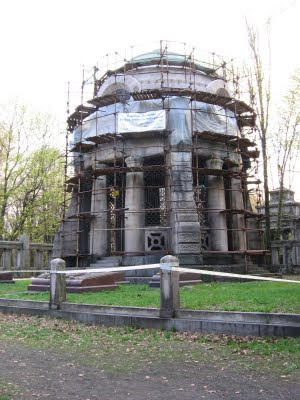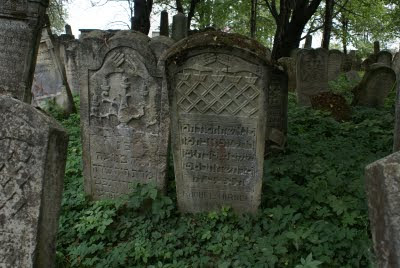Here's a link to my JTA article on Holocaust recognition, acknowledgment and commemoration in post-communist Europe.
By Ruth Ellen Gruber, October 28, 2009
ROME (JTA) -- A row of empty shoes where Jews were shot dead on the bank of the Danube River in Budapest. The image of a grand synagogue chiseled into stone at the place it once stood in Bratislava. A museum, a wall of names and a vast symbolic field of ashes at the site of the Belzec death camp in Poland. A giant menorah and the statue of a tortured figure at a corner in the Ukrainian city of Lviv.
These are just a few of the monuments to victims of the Holocaust that have been erected in Eastern Europe in the 20 years since the fall of communism opened the way to a dramatic, often painful and still ongoing confrontation with history in that region.
Under communism, Jewish suffering in the Holocaust generally was subsumed as part of overall suffering during World War II. Most Holocaust or World War II memorials in communist Europe -- even at death camps such as Auschwitz and Buchenwald -- honored generic "victims of Nazism" or "victims of Fascism."
But over the past two decades numerous new memorials have been built, countless plaques have been affixed, educational programs have been instituted, Holocaust museums have been established, and a number of countries have adopted an annual Holocaust Remembrance Day to serve as a focal point for study and commemoration.
"Education is a slow process, and changing inherited and accepted concepts and beliefs is a difficult task in any context," said Samuel Gruber, president of the International Survey of Jewish Monuments. "In this light, I think we can look at amazing progress over the past two decades."
But the process has been far from smooth, and far from complete, and it varies widely from country to country and locale to locale.
"The way that the Holocaust is remembered is a good indication of the health of a nation," said Warren Miller, chairman of the U.S. Commission for the Preservation of America's Heritage Abroad, which has sponsored a number of Holocaust memorial projects.
"When the Holocaust is denied, freedom is under assault," he said. "Where the Holocaust and its victims are remembered, freedom is secure."
Some states, particularly those that were themselves victims of the Nazis, have taken many measures to confront their history and recognize local culpability in the deportation and murder of Jews.
In Poland, for example, the memorials and museums at Holocaust sites such as Auschwitz and Belzec have been revamped to provide both factual information and context. New memorial plaques have been put up throughout the country, and numerous public and private education projects on the Holocaust and Jewish history have cropped up.
"But when the subject focuses on questions about the Polish role as collaborators with the Nazis or merely Polish self-expressions of anti-Semitism, it is still quite controversial," said Rabbi Andrew Baker, the American Jewish Committee's director of international Jewish affairs.
In some countries, nationalism, local pride and complex political and other legacies have put up obstacles to an honest evaluation.
"Progress is relative," Gruber said. "These are still fledgling democracies. Some countries are much further along the path to historical accountability and sincere commemoration than others, but many have had further to go."
In countries such as Slovakia, Hungary and Romania, which were allied with the Nazis, honest evaluation of the past means acceptance of direct local participation in the Holocaust.
Education is vital, said Maros Borsky, director of the Slovak Jewish Heritage Center. "The evil that happened in society will not be healed, but the next generation must learn about it," Borsky said.
In the countries that once formed part of the Soviet Union, the problems are compounded by other issues. In the Baltic countries in particular, nationalists long have regarded the Nazis as the lesser of two wartime evils -- "liberators" against the Russians who occupied their countries.
In 2002, for example, Latvian President Vaira Vike-Freiberga had to intervene directly to ensure that the inscription on a monument to 25,000 Jews killed in the Rumbula Forest near Riga included mention of Latvian collaborators as well as Nazis among the perpetrators.
"She said this is a place of national shame," Miller said. "It was a huge step forward and an example for other European leaders to follow."
In Ukraine, nationalist aspirations after decades of Russian domination have eclipsed the memory of Jewish suffering, particularly in western Ukraine, which before World War II was part of Poland and had a complex multiethnic profile.
"Generally speaking, Jewish issues, including the Holocaust, are still not seen as part of one's own history," said Tarik Cyril Amar, academic director of the Center for Urban History of East Central Europe in Lviv.
The high-profile dedication Oct. 8 of a national Holocaust memorial in the Romanian capital Bucharest illustrated many of these points.
Under Marshal Ion Antonescu, Romania was an ally of Nazi Germany, and deportations of Jews ordered by Antonescu resulted in the deaths of some 280,000 Jews. Even after the fall of communism, this fact was largely ignored or minimized, and Antonescu is often viewed as a hero by Romanian nationalists.
"Six years ago there was no difficulty in getting Romanian leaders to acknowledge that there was a Holocaust in their country, but they only understood this as what Hungarians did to Jews in Romanian territory under their control," Baker said.
Construction of the monument and marking Oct. 9 as Holocaust Commemoration Day were mandated by an international commission on the Holocaust in Romania, headed by Nobel Prize laureate Elie Wiesel, which released a 400-page report in 2004 as Romania was preparing to enter the European Union.
Political dignitaries, Holocaust survivors and religious leaders from Europe, Israel and the United States attended the ceremony, and Romanian President Traian Basescu spoke.
The Romanian state and Romanian society, Basescu declared, "reaffirm their decision to assume the blame for the past and to uncover the historic memory in the spirit of truth."
The memorial, said Baker, who attended the ceremony and is a member of the Holocaust Commission, can be seen "as a culmination of the process of getting Romanians to confront their own Holocaust history."
Nonetheless, he added, "It was still ironic that while President Basescu spoke very clearly in his dedication remarks about the role of Antonescu in the Holocaust, he told me later that same day that he believes over 50 percent of the Romanian population still views Antonescu positively."
"So much has been done,” Baker said, “but there is still much to do."Read full article at JTA.org
I was unable in an 800-word story to incorporate all the material I obtained in interviews for the piece.
But -- Sam Gruber has now posted on his blog his full responses to my questions. We have discussed these issues many times over the years, and in some ways, his responses mirror a lot of my thinking (but expressed much more eloquently!). We come to the topic from different directions, too.
You can read the full text of the interview by clicking HERE.

























